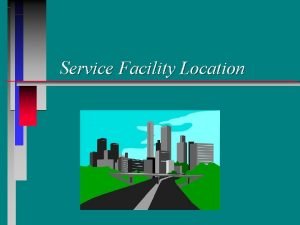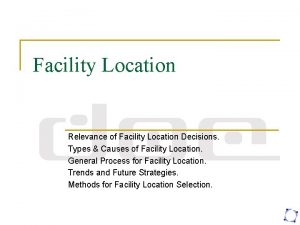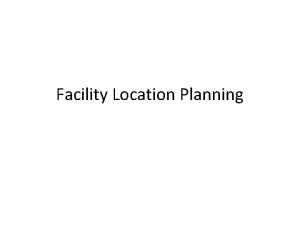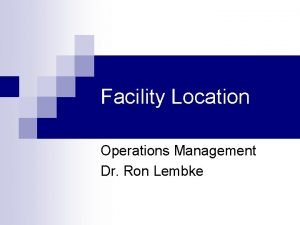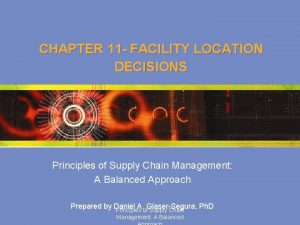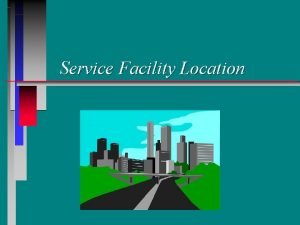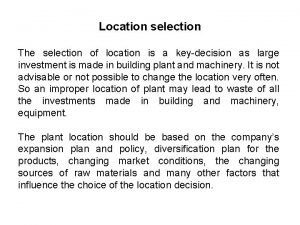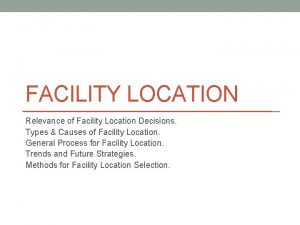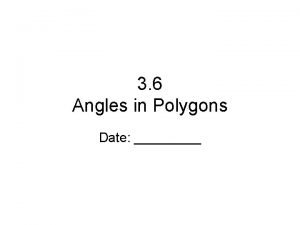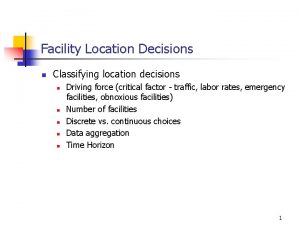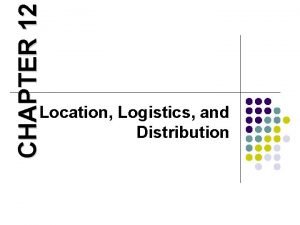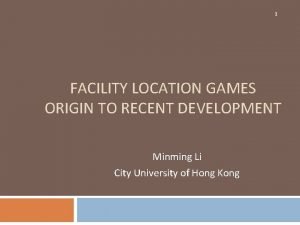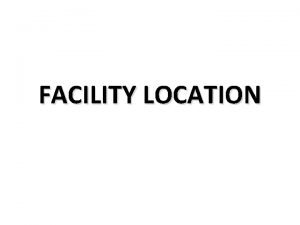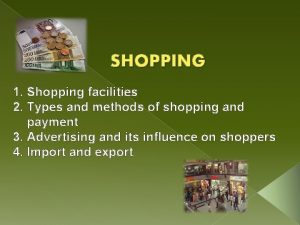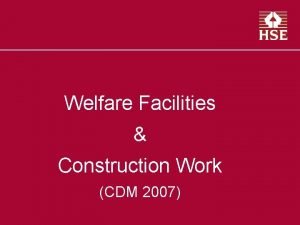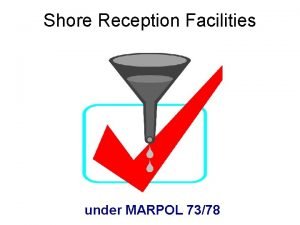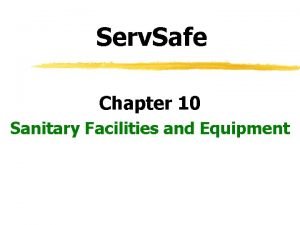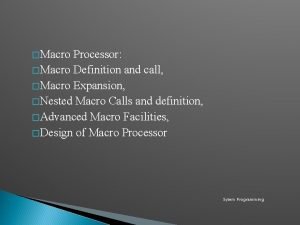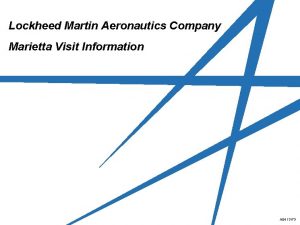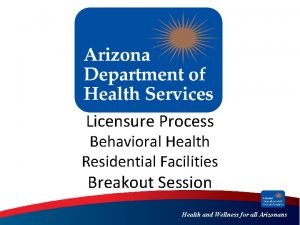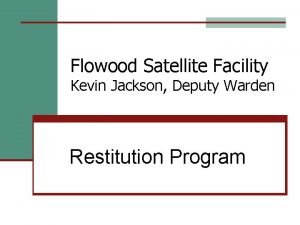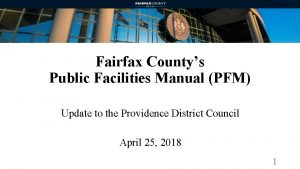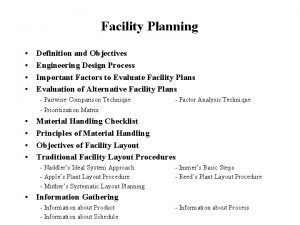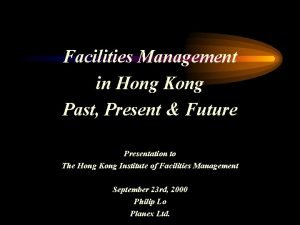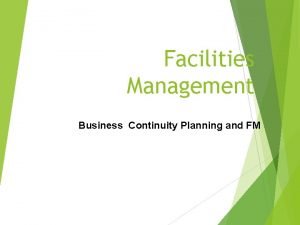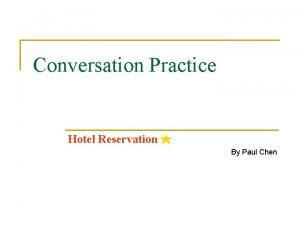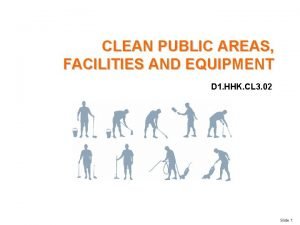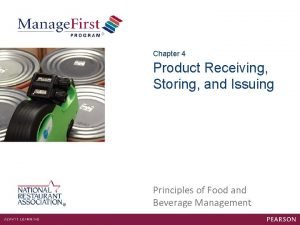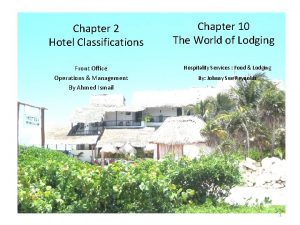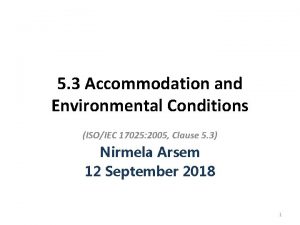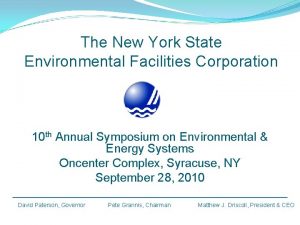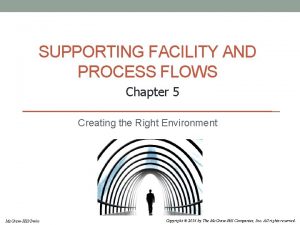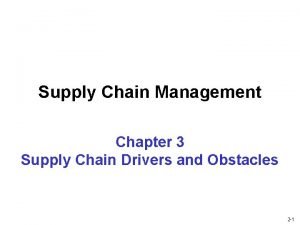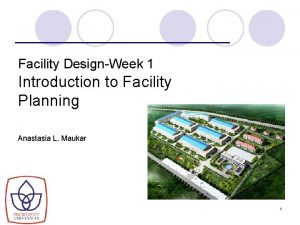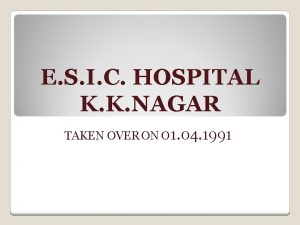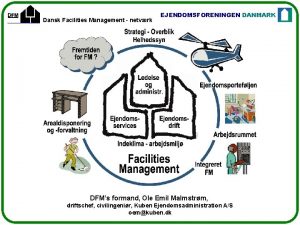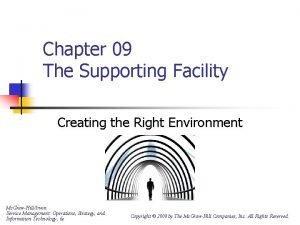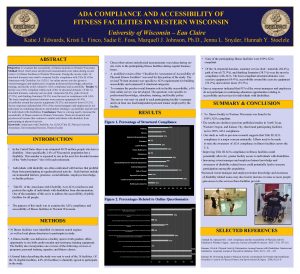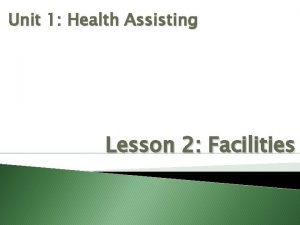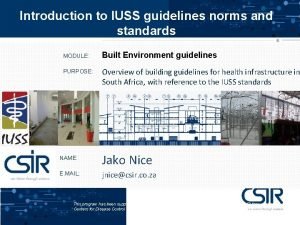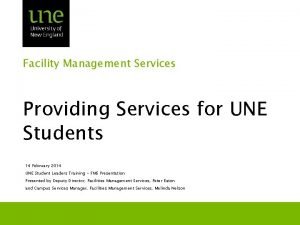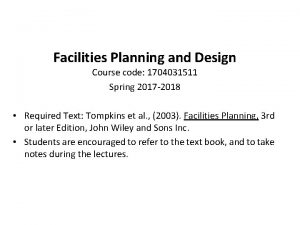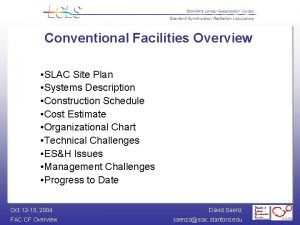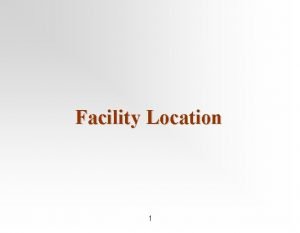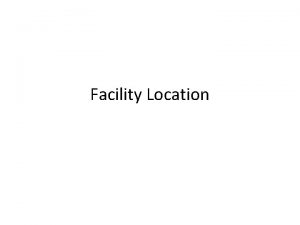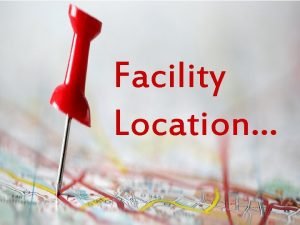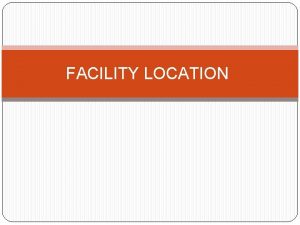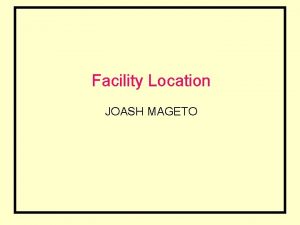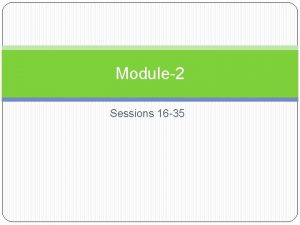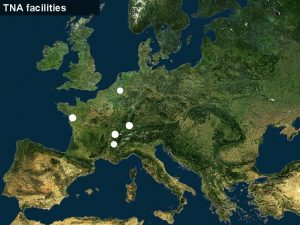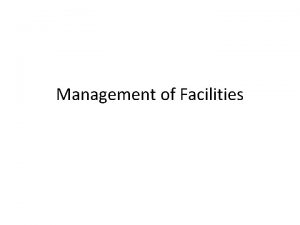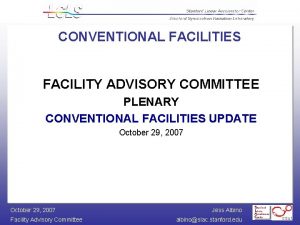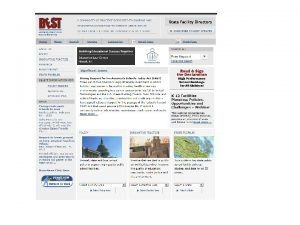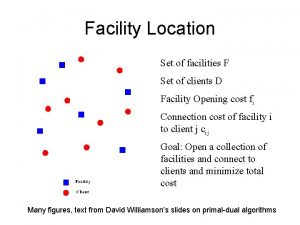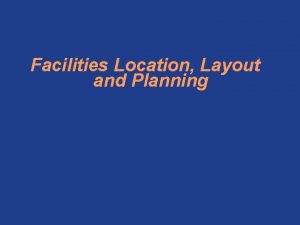FACILITY LOCATION Examples Outline HW 3 Facilities Location


















































- Slides: 50

FACILITY LOCATION

Examples ? ? ?

Outline • • HW # 3: Facilities Location Decisions – Strategic importance – Sequence – Methods of evaluating location alternatives 1. 2. 3. 4. Complete Enumeration The Factor-Rating Method Center-of-Gravity Method Transportation Method

Where would you locate… An amusement park? A new pharmacy? Amazon’s new distribution center?

Facility Location Decisions ¨ Cost focus ¨ Revenue varies little between locations ¨ Location is a major cost factor ¨ ¨ Affects shipping & production costs (e. g. , labor) Costs vary greatly between locations

FACILITY LOCATION A major strategic decision is where to place a new facility or facilities. With the increased emphasis on globalization, this decision involves great flexibility and complexity. The term “facility” is used to cover: Plants Warehouses Hotels Medical Clinics Fire Stations Distribution Centers Post Offices Libraries Schools Why is GE located in Wilmington? What are Maquiladoras and where are they located? Why did the Japanese auto firms locate in Ohio & Kentucky? Why is Walt Disney World in Orlando? Are location decisions important in the service sector?

Facilities Location For the region under consideration, the Facility Planner generally must answer the following questions: 1. How many facilities should be established? This includes the options of: Opening new ones Closing existing ones Expanding existing ones 2. Where should they be located? 3. What should be their sizes (capacities)? (including configuration of products/services) 4. How should the facility configurations change over time? 5. What should their service territories be?

Factors to consider… Factors to consider Distances to surrounding community? Patient traffic? An amusement park? Length of summer season? Sufficient population? Quantity of labor? Labor costs? Local laws? A new pharmacy? Distances from online customers? Transportation costs? Unions? Taxes? Amazon’s new distribution center?

Location Decisions • Long-term strategic decisions • Usually expensive & difficult to reverse • Affect fixed & variable costs – Transportation cost is up to 25% of product price – Other costs: Taxes, wages, rent, etc. • Objective: Maximize benefit of location to firm

Location Decision Sequence Region/Community Country Site

Factors Affecting Country Decision n Economic and political stability n Infrastructure n Location of markets n Labor costs n Trade barriers n…

Ranking of Business Environment

Factors Affecting Region/Community Decision • • • Proximity to customers & suppliers Transportation availability Population Climate Attractiveness of region Local laws/taxes Land/construction $$$ Corporate desires …

Factors Affecting Site Decision • Access to customers (air, rail, highways, etc) • Site size and cost • Zoning restrictions • Proximity of services • Transportation in/out • Environmental impact.

Hard Rock Cafe .

Location Evaluation Methods 1. Complete enumeration 2. Factor-rating method 3. Center of gravity method 4. Transportation method

1. Complete Enumeration n Given 3 potential locations: A, B, C üA üB üC ü AB 2 n-1 possible configurations = 23 -1 = 7 ü AC ü BC ü ABC Open the set of locations that satisfy de and capacity constraints at the lowest c

2. Factor-Rating Method • Most widely used location technique • Rates locations using factors – Intangible (qualitative) factors • education quality, labor skills, etc. – Tangible (quantitative) factors • Production costs, cost of living, etc. • Decision based on weighted average

5 Steps in Factor Rating Method 1. List relevant factors 2. Assign importance weight to each factor ¨ e. g. , 1 to 10, with 10 being the most important 3. Score each location along the factor dimensions ¨ e. g. , 0 to 10, with 10 being the best 4. Multiply weights by scores and sum for each location 5. Choose the location with the most points

Factor Rating Example - 3 locations: A, B, C 1. List relevant factors 2. Assign weights to each factor (let’s use weights 0 -1) 3. Score each location on each factor Factor Cost Proximity to trans. Taxes Labor weight A 0. 3 0. 2 0. 1 0. 4 B C

Factor Rating Example - 3 locations: A, B, C 1. List relevant factors 2. Assign weights to each factor (let’s use weights 0 -1) 3. Score each location on each factor 4. Multiply the weight and score and sum for each location (0. 3)(10)+(0. 2)(7)+(0. 1)(7)+(0. 4)(6) = 7. 5

Factor Rating Example - 3 locations: A, B, C 1. List relevant factors 2. Assign weights to each factor (let’s use weights 0 -1) 3. Score each location on each factor 4. Multiply the weight and score and sum for each location 5. Choose the location with the most points. A is best

3. Center of Gravity Method • Locates a single facility to serve many destinations (customers) • Attempts to minimize the cost of distributing products to surrounding markets

Center of Gravity Method Steps • Given each existing destination’s – X and Y coordinates – expected volume of goods to be shipped there • Center of gravity location = weighted average of X & Y coordinates

Center of Gravity Method Equations X Coordinate = Y Coordinate = xi = x coordinate of location i yi = y coordinate of location i Vi = Volume of goods moved to or from location i

y Center of Gravity Example Suppose Buy. com serves 4 cities with the following volumes & coordinates x Volume Location Chicago Pittsburgh New York Atlanta Vi 200 100 200 X-coord xi 30 90 130 60 Y-coord yi 120 110 130 40 Where should the company position a new warehouse to minimize the cost of distributing to these 4 markets?

y Center of Gravity Example X Suppose Buy. com serves 4 cities with the following volumes & coordinates Center of gravity = (66. 7, x Volume Location Chicago Pittsburgh New York Atlanta Vi 200 100 200 X-coord xi 30 90 130 60 Y-coord yi 120 110 130 40 = 12000 SVi*xi = 40000 SVi = 600 = Vi*xi 200*30= 6000 100*90 = 9000 100*130 200*60 = 13000 40000 = 66. 67 600 Vi*yi 200*120= 24000 100*110 = 11000 100*130 200*40 = 13000 = 8000 SVi*yi = 56000 600 = 93. 33

4. Transportation Method • Finds amount to be shipped from several sources to several destinations • Used primarily for industrial locations • Type of linear programming model Objective: Minimize total production & shipping costs – Constraints • Production capacity at source (factory) • Demand requirement at destination –

Transportation Method With the trend towards globalization, supply chains are becoming more complex and longer in terms of lead-time, distances, handling of goods, containerization, information systems, tariffs and duties, and the impact on cost and profit.

Transportation Method Therefore, it is essential to improve the logistics (distribution/transportation) involved with the delivery of raw material and finished goods or the appropriate equivalents in the service sector.

Methods for Coming Up with Solutions to A Transportation Problem Consider a manufacturing company that must determine the best pattern of shipments from several supply sources (e. g. , plants) to several demand destinations (e. g. , warehouses) so as to minimize total transportation cost.

Methods for Coming Up with Solutions to A Transportation Problem There is a cost to ship per unit as shown in the table below. The table also shows that each plant has a limited supply of products and each warehouse has a specific demand for the products (Note: total supply = total demand). What is the best way to distribute the products in order to minimize costs?

Warehouse FACILITY W X Y Z Supply A $ 25 $ 65 $36 $60 18 B $55 $ 30 $ 45 $38 14 C $40 $50 $ 26 $65 14 Demand 10 12 15 9 46

There are several ways for coming up with a feasible solution (the solution that meets the demand is within the capacity) to a transportation problem. In this class, we will present one method, namely the Northwest Corner method. Most of the time, the initial solutions obtained from such methods are not the best (the technical word for it is optimal). However, these methods are useful in coming up with a starting solution quickly and effectively. Improvement techniques are available that allow for improvement of any feasible solution and eventually could lead to the optimal solution.

The Northwest Corner Method: The procedure works as follows: 1. We begin in the upper left (or northwest) corner of the transportation tableau and assign as many units as possible (in the sense of satisfying the corresponding customer but without violating the warehouse capacity).

The Northwest Corner Method: 2. Update the demand of the corresponding customer (respectively, the capacity of the warehouse) by subtracting the amount assigned from the initial demand (respectively capacity).

3. If the demand is fully satisfied, then cross out the corresponding column. On the other hand, if the Supply is fully exhausted, then cross out the corresponding row. 4. Continue applying this procedure to the most northwest cell in the tableau that does not lie in a crossed-out row or column.

5. There will come a point where there is only one cell that can be assigned a value. Assign a shipment to this cell in the amount of its row or column demand. Stop at this stage. An initial feasible solution has been obtained.

Let us apply the Northwest Corner to come up with a feasible assignment to the following problem:

Warehouse Plant W X Y Z Supply A $ 25 $ 65 $36 $60 18 10 B $55 8 $ 30 $ 45 4 C Demand $40 10 0 8 0 $50 12 4 0 $38 10 $ 26 $65 5 9 15 5 0 9 0 14 10 0 14 9 0 46

Is the solution feasible? (Why or why not? ) What is the cost of this solution? $25 x 10 = 250 $65 x 8 = 520 $30 x 4 = 120 $45 x 10 = 450 $26 x 5 = 130 $65 x 9 = 585 Total Cost = $2, 055

Service Location Strategy – How Hotel Chains Select Sites – The Telemarketing Industry – Geographic Information System

Federal Express • Stresses “hub” concept • Advantages: enables service to more locations with fewer aircraft – enables matching of aircraft flights with package loads – reduces mishandling and delay in transit because there is total control of packages from pickup to delivery –

Service Location Decisions • Revenue focus – Costs vary little between market areas • Location is a major revenue factor Affects amount of customer contact – Affects volume of business –

Organizations That Need To Be Close to Markets • Government agencies Police & fire departments – Post Office – • Retail Sales and Service Fast food restaurants, supermarkets, gas stations – Drug stores, shopping malls – Bakeries –

Organizations That Need To Be Close to Markets - continued • Services Doctors, lawyers, accountants, barbers – Banks, auto repair, motels – • Manufacturers Makers of bulky or heavy products – Japanese car makers – German car makers – Auto parts suppliers –

Components of Volume and Revenue for a Service Firm • Purchasing power of customer drawing area • Service and image compatibility with demographics of the customer drawing area • Competition in the area • Quality of the competition • Uniqueness of the firm’s and competitor’s locations • Physical qualities of facilities and neighboring businesses • Operating policies of the firm • Quality of management

Telemarketing and Internet Industries • Require neither face-to-face contact with customers (or employees) nor movement of material • Presents a whole new perspective on the location problem

Geographic Information Systems • New tool to help in location analysis • Enables combination of many parameters

Final Thought The ideal location for many companies in the future will be a floating factory ship that will go from port to port, from country to country – wherever cost per unit is lowest.
 Layout lokasi
Layout lokasi Service facility location
Service facility location Centroid method of facility location
Centroid method of facility location Facility location planning
Facility location planning Center of gravity method facility location example
Center of gravity method facility location example What is plant layout and its objectives
What is plant layout and its objectives Location
Location Service facility location
Service facility location Facility location factors
Facility location factors Facility location decisions are complex because
Facility location decisions are complex because Facility location
Facility location Location decisions
Location decisions Logistics system design matrix
Logistics system design matrix Facility location game
Facility location game Examples of facilities
Examples of facilities Methods of shopping
Methods of shopping Sandwich sentences
Sandwich sentences A cross country skier moves from location a
A cross country skier moves from location a What is location planning in operations management
What is location planning in operations management Cdm welfare facilities
Cdm welfare facilities Seperation
Seperation Sanitary equipment facilities definition
Sanitary equipment facilities definition Anop in macro
Anop in macro Lockheed martin georgia
Lockheed martin georgia Article 7 behavioral health residential facilities
Article 7 behavioral health residential facilities Glp practices
Glp practices Mississippi restitution centers
Mississippi restitution centers Fairfax county pfm
Fairfax county pfm Objectives of facilities planning
Objectives of facilities planning Sss facility management services
Sss facility management services Facilities business continuity plan
Facilities business continuity plan Conversation about hotel
Conversation about hotel Cleaning public areas facilities and equipment
Cleaning public areas facilities and equipment Purchasing, receiving, storing and issuing comes under
Purchasing, receiving, storing and issuing comes under Hotel classifications
Hotel classifications Iso 17025 environmental conditions
Iso 17025 environmental conditions Gigp-28
Gigp-28 Supporting facilities example
Supporting facilities example Framework for structuring drivers
Framework for structuring drivers Johnson's rule
Johnson's rule Vinci facilities maximo
Vinci facilities maximo Facility planning
Facility planning Kk nagar esi hospital facilities
Kk nagar esi hospital facilities Dansk facilities management
Dansk facilities management Supporting facilities
Supporting facilities Ada standards for fitness facilities
Ada standards for fitness facilities Lesson 2 healthcare facilities
Lesson 2 healthcare facilities Iuss design guidelines for health facilities
Iuss design guidelines for health facilities Une student id
Une student id Reject allowance problem facilities planning
Reject allowance problem facilities planning Conventional facilities
Conventional facilities

